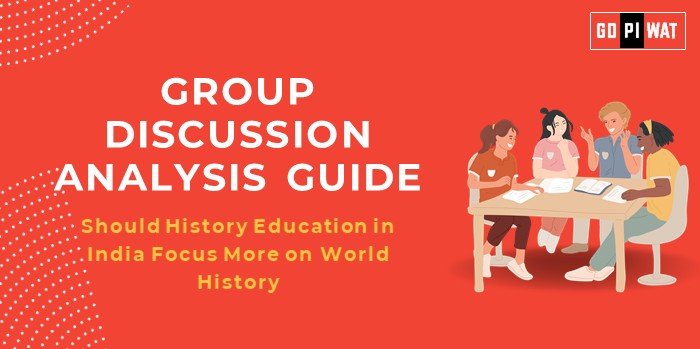📋 Group Discussion Analysis Guide: Should History Education in India Focus More on World History?
🌐 Introduction to the Topic
History education shapes perspectives, contributing to a nation’s worldview and its place on the global stage. With India’s rich history emphasized in school curricula, there is an ongoing debate about balancing national history with world history. As globalization deepens, understanding international events and global civilizations may be increasingly vital.
📊 Quick Facts and Key Statistics
- 📚 Current Syllabus: India’s history curriculum at school level focuses 75% on Indian history and 25% on world history.
- 🌍 Global Comparison: In the US, high school students cover world history from diverse regions, including Europe, Asia, Africa, and Latin America.
- 🎓 UNESCO Recommendation: Promotes global history education as a pathway to global citizenship, fostering mutual understanding and tolerance.
- 📈 Higher Education Trends: Many Indian universities offer specialized world history programs, indicating rising interest at advanced levels.
🧑🤝🧑 Stakeholders and Their Roles
- 🏫 Education Boards (CBSE, ICSE, State Boards): Define and update curricula to balance Indian and world history content.
- 👨🏫 Teachers and Schools: Play a central role in contextualizing history and delivering a balanced perspective on global events.
- 🧑🎓 Students: Future global citizens who benefit from a broadened perspective.
- 🏛️ Government and Policy Makers: Decide on curriculum reforms and align educational standards with national goals.
🏆 Achievements and ⚠️ Challenges
✅ Achievements
- 🇮🇳 Strength in National Identity: India’s current focus has fostered a strong understanding of its rich cultural and historical heritage.
- 🌍 Growing Interest in World Affairs: Increasing participation in global programs has shown student interest in world history.
- 🎓 Influence on Higher Studies: Expansion of international history programs in Indian universities indicates demand and benefit of a global historical perspective.
⚠️ Challenges
- 🌎 Limited Exposure to Global Context: Students often lack comprehensive knowledge about historical developments in other regions.
- 📖 Content Overload: Expanding the curriculum to include more world history may overwhelm students already managing a rigorous syllabus.
🌍 Global Comparisons
- 🇨🇳 China: Emphasizes both national and world history, focusing on contributions to civilization and interactions with other regions.
- 🇬🇧 United Kingdom: Provides a balanced curriculum with a focus on European history alongside global interactions.
📖 Case Study: International Baccalaureate (IB) Program in India: Offers a balanced curriculum with robust world history content, preparing students for global citizenship.
🗣️ Structured Arguments for Discussion
- ✅ Supporting Stance: “Incorporating more world history in Indian education will equip students with a global perspective and prepare them for international roles.”
- ⚠️ Opposing Stance: “Expanding world history coverage might dilute focus on India’s cultural identity and heritage, critical for national unity and pride.”
- ⚖️ Balanced Perspective: “A curriculum combining Indian and world history will help students value their heritage while fostering a global understanding.”
💡 Effective Discussion Approaches
- 📊 Opening Approaches:
- Statistical Impact: “As globalization expands, 70% of Fortune 500 companies seek employees with knowledge of international affairs and history.”
- Comparative Approach: “Countries like China and the UK prioritize world history alongside national history, creating a more balanced perspective for students.”
- Case Study Opening: “The International Baccalaureate’s success in India shows how world history can coexist with national history effectively.”
- 🛠️ Counter-Argument Handling:
- Acknowledge India’s unique historical value.
- Suggest a framework where Indian history remains primary but integrated with global perspectives.
📈 Strategic Analysis of Strengths and Weaknesses (SWOT)
- ✨ Strengths: Strong national identity, increasing student interest in world history.
- ⚠️ Weaknesses: Overloaded curriculum, limited global content.
- 🌟 Opportunities: Expand cultural understanding, prepare students for global careers.
- ⚡ Threats: Potential loss of focus on national history.
💼 Connecting with B-School Applications
- 🌍 Real-World Applications: Topics in world history are crucial for projects in international business, global politics, and trade.
- 🎯 Sample Interview Questions:
- “Why is an understanding of world history important for business students today?”
- “How does global history inform modern economic policies?”
- 💡 Insights for B-School Students: Developing global perspectives, understanding cross-cultural management, and analyzing historical economic shifts.


